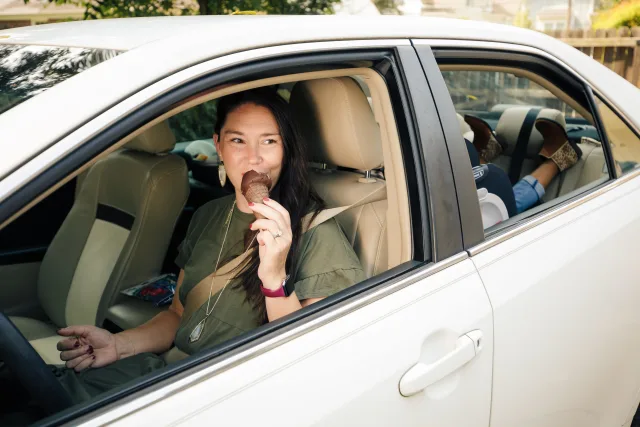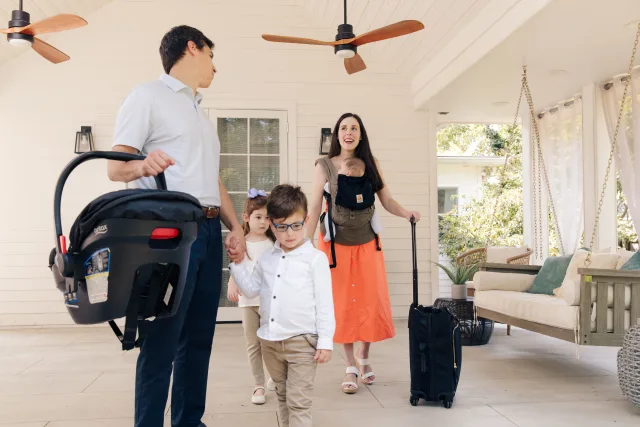If you are flying with kids, then you must have already concluded that the fun you will have at your destination will outweigh the challenges of getting there. Here are our top safe airplane travel tips for flying with your littles.
Safe Airplane Travel Tips
1. Everyone gets a ticket.
Make sure every member of the family gets their own seat, even your youngest travelers. Yes, we know how tempting it is to check that lap child box. Your baby could cost less than your checked suitcase, why not take advantage?!
That was a trick question! There are several reasons to avoid flying with lap babies. First, the FAA recommends that all passengers under 40lbs — yes, even the under-twos — fly restrained in their car seats. Aviation safety is important! During turbulence or runway incidents, proper restraint can mean the difference between injuries and your little one coming away unscathed. Most of the car seats for sale in the United States do have aircraft approval, so you’ll likely be able to use the car seat you already have.
Beyond the safety reasoning, flying with your car seat is easier than skipping it! Yes, for real! Instead of being your baby’s personal jungle gym for the duration of your flight, your lap will be empty and your hands-free while that car seat keeps your baby happily contained in their own space. And you’ll walk right off the plane with your child’s car seat in hand, ready to tackle whatever adventures await!
We know that it can place a financial strain on that travel budget to buy an extra plane ticket. But even if it means the budget for the rest of the trip is a little skimpier, safe airplane travel for everyone is a priority!
2. Bring your own car seats. (BYO…CS?)
We’ve already covered the safety and sanity benefits of using a car seat on the plane for any passengers who weigh less than 40 lbs. But you’ll reap the rewards of your labor even beyond the flight! You won’t be pacing at baggage claim awaiting the arrival of your child’s checked car seat (and hoping that it arrives on time and in usable condition); you won’t be panicking at the rental car desk when you see the sad state of the rental car seats they offer; you won’t have to wing it when you install an unknown rented seat without a manual. Not you! You’ll be the one confidently buckling your child into your own safe, perfectly installed car seat and heading on your way. Win-win-win!
If your child is under 40 pounds, the car seat needs to be ON the plane with your child harnessed in it. It’s the safest way to travel for your child and the car seat. Yes, it’s heavy, awkward and annoying but so is life with kids; you’ve got this! Know where the aircraft approval on your seat is so you can show it to flight attendants if asked.
Check out this video for our recommendations on the best car seats for the airplane.
3. Keep the big kids safe too.
40 is the magic number — that is, 40 lbs is when the average airplane lap belt begins to fit passengers properly. What does that mean for you? If you’re flying with a child over 40 lbs, you have to consider your whole itinerary! If you need a harnessed car seat at your destination to transport your child safely, we’d still bring it onboard the plane and use it in flight, since that’s the best way to make sure your seat arrives in tip-top shape (have you seen how baggage handlers throw those checked bags around?!). However, if you won’t need your own harnessed car seat during your trip — we will discuss this more below! — you know when your big kids are big enough to skip the car seat onboard.
4. Think about all your options.
Let’s keep talking about those big kids who can safely fit in an airplane seatbelt without a car seat. If you’d like to avoid bringing their car seat onboard, here are some safe workarounds. If you’re meeting family or friends when you arrive, you can order a car seat online and have it shipped to their address so they can have it ready to go in the passenger pick-up area.
Or, if they offer to let you borrow a used car seat of theirs, do your homework to make sure it’s a safe option for your child: has it ever been in a crash, cleaned improperly, or otherwise damaged? Are all parts and pieces present? Is it an appropriate choice for your child’s age, size, and stage? While we generally recommend against used or secondhand car seats, borrowing a safe seat from someone you trust might work for you.
For booster-ready big kids, it’s not an option to sit in their seat onboard the plane. But you can easily bring it along! Your child can bring a backless booster onboard the plane as their carry-on item and stow it in the overhead bin. If you need a high back booster, choose one that folds to fit in an overhead bin or one with a detachable back that fits in your checked luggage (where it will be well protected by clothing!) so the backless part can be carried on the plane.
5. Frequent flyer? Consider adding a just-for-travel car seat to your wish list.
If you’re still hesitant to take to the skies with your child’s car seat in tow, we’d bet that one thing holding you back is the idea of dragging your kid’s thirty-pound convertible car seat through the airport. Are we right or are we right? While many of our kids ride around day to day in fancy, fully-featured car seats weighing more than the tiny passengers they protect, and almost all of those car seats are FAA Approved, it’s totally reasonable to want something a little easier for travel. We really love the Cosco Scenera Extend or Safety 1st Ellaris for rear-facing kiddos and the Wayb Pico for their forward-facing older siblings. Each of these options are lightweight, and yes, they pass the exact same crash testing as the giant seats you have in your minivan. One-time travelers might not opt to invest in separate car seats for family trips, but if you fly with your little ones more often, lighter-weight seats just might be worth it!

6. Strategize and simplify.
What are the biggest pain points of air travel? Booking your flights? Getting through security or layovers, or navigating the airport with all your luggage? Think about each of these stages and how you can streamline each process.
Book a direct flight if you can, and think about the timing of your travels compared to your kids’ naptime or snack schedule. Plan how you’re going to move through the airport. Stroller? Babywear? Will you use car seat backpacks or wheeled carts to get to the gate? Check out our Amazon Live on airplane travel for our favorites.
Pack as light as possible (or just laugh at this suggestion, if you’re traveling with toddlers!) and check your suitcases through to your final destination. Organize your carry-on luggage in a way that will make security a little less painful — keep any liquids, baby items, and electronics in one adult’s backpack so that you don’t find yourself digging through multiple bags in front of the x-ray machine. Avoid packing any of these must-remove items in your kids’ carry-on bags so that their stuff can be placed on the conveyor belt as-is; you can hand out the tablets once you’re at the gate.
7. If it’s checked, you must protect.
If you’re still not convinced that your car seat should come on board with you, take care of it before you drop it off at the check-in counter. See if your car seat’s manufacturer offers a protective travel bag specific for your car seat — some of these bags even come with a protection guarantee that covers a new car seat if yours doesn’t make it off the plane in usable condition. You could also box up your car seat in its original packaging or in another protective container.
It’s a myth that a car seat automatically needs to be trashed after it’s checked under a plane. However, if the seat arrives at baggage claim with any damage at all, it’s considered unusable. Inspect your car seat carefully upon arrival and have a backup plan in mind if you find yourself without a usable seat after touchdown!
8. Practice and prepare.
In all your preparation, don’t forget that you have to actually use that car seat at your destination! If you’ll need to install your infant seat baseless or if you’re traveling with a seat you don’t use on a daily basis, make sure you’re comfortable with the install before you head out. If possible, go through the process in a few different vehicles so you’re ready to handle whatever car the rental company throws at you. It can be intimidating to step out of your car seat comfort zone — whether you’re used to the convenience of an infant base, or you’ve only ever installed your toddler’s heavy monstrosity of a convertible car seat, you’ll want to expand your skills before the big day. When the time comes to install your seat in an unfamiliar vehicle, you’ll be ready to go.
9. Before you take flight, review the child passenger safety laws specific to your destination.
It’s the most wonderful time of year, don’t get caught off guard. While we can’t promise a stress-free travel experience, we can assure you with proper planning, research, and maybe a glass of wine in-flight, you CAN do this!
Whether you’re flying with kids or flying with a baby, it’s not only important to travel safely– but to keep your little ones happy and occupied on the journey! Being prepared and confident before your flight is key! Check out my recent Amazon Live, where I share my favorite products, toys, fidgets, and tips for flying with kids. Read this post for how to install a car seat on an airplane.
For more information about traveling with children check out my Safe in the Sky Airplane Travel Course. And, be sure you are following Safe in the Seat on Facebook and Instagram!
Affiliate links are included above. Safe in the Seat earns a small commission when you purchase through these links at no cost to you. We so appreciate your support.






